A Decision-Making Tool for Port Operations Based on Downtime Risk and Met-Ocean Conditions including Infragravity Wave Forecast
Abstract
1. Introduction
2. Materials and Methods
2.1. Study Area
2.2. Field Campaign
2.3. Gravity and Infragravity Waves Forecast
2.3.1. Input and Output Parameters
2.3.2. Empirical Formulation to Compute Infragravity Waves Heights
2.3.3. Regression Model
2.4. Downtime Risk Forecast
2.4.1. Input and Output Parameters
2.4.2. Classification Model
3. Results and Discussion
3.1. Gravity and Infragravity Waves Forecast
3.2. Downtime Risk Forecast
4. Conclusions
Author Contributions
Funding
Institutional Review Board Statement
Informed Consent Statement
Data Availability Statement
Acknowledgments
Conflicts of Interest
References
- van Deyzen, A.F.J.; Beimers, P.B.; van Der Lem, J.C.; Messiter, D.; De Bont, J.A.M. To Improve the Efficiency of Ports Exposed to Swell. In Proceedings of the Australasian Coasts & Ports Conference 2015: 22nd Australasian Coastal and Ocean Engineering Conference and the 15th Australasian Port and Harbour Conference, Auckland, New Zealand, 15–18 September 2015; pp. 919–926. [Google Scholar]
- McComb, P.; Zyngfogel, R.; Gomez, B.P. Predicting Infragravity Waves in Harbours—An Evaluation of Published Equations and Their Use in Forecasting Operational Thresholds. Coast. Eng. Proc. 2020, 36, 7. [Google Scholar] [CrossRef]
- Sun, J.; Wang, H.; Chen, J. Decision-Making of Port Enterprise Safety Investment Based on System Dynamics. Processes 2020, 8, 1235. [Google Scholar] [CrossRef]
- Kadir, Z.A.; Mohammad, R.; Othman, N.; Amrin, A.; Muhtazaruddin, M.N.; Abu-Bakar, S.H.; Muham, F. Risk Management Framework for Handling and Storage of Cargo at Major Ports in Malaysia towards Port Sustainability. Sustainability 2020, 12, 516. [Google Scholar] [CrossRef]
- Rosa-Santos, P.J.; Taveira-Pinto, F. Experimental Study of Solutions to Reduce Downtime Problems in Ocean Facing Ports: The Port of Leixões, Portugal, Case Study. J. Appl. Water Eng. Res. 2013, 1, 80–90. [Google Scholar] [CrossRef]
- Spanish Port Authority ROM 3.1-99. Planning, Management and Operation in Port Areas. In Project of the Maritime Configuration of Ports; Access Channels and Floating Areas: Madrid, Spain, 2000; Volume 3, ISBN 9788578110796. [Google Scholar]
- Thoresen, C.A. Port Designer’S Handbook: Recommendations and Guidelines; Thomas Telford Publishing: London, UK, 2003; ISBN 0727732242. [Google Scholar]
- PIANC Criteria for Movements of Moored Ships in Harbours—A Practical Guide; MarCom Working Group: Brussels, Belgium, 1995; ISBN 2-87223-070-X.
- Spanish Port Authority ROM 2.0-11. Design and Construction of Berthing & Mooring Structures. In Recommendations for the Design and Execution of Berthing and Mooring Works; V.A. Impresores: Madrid, Spain, 2011; ISBN 9788488975409. [Google Scholar]
- Prpić-Orsić, J.; Slapnicar, V.; Turk, A. Berth Operability Estimation Related to Ship Motion. Trans. Famena 2014, 38, 13–24. [Google Scholar]
- Kwak, M.S.; Moon, Y.H.; Pyun, C.K. A Study on Analysis of Moored Ship Motion Considering Harbor Resonance. J. Korean Soc. Civ. Eng. 2013, 33, 595–608. [Google Scholar] [CrossRef][Green Version]
- Figuero, A.; Sande, J.; Peña, E.; Alvarellos, A.; Rabuñal, J.R.; Maciñeira, E. Operational Thresholds of Moored Ships at the Oil Terminal of Inner Port of A Coruña (Spain). Ocean Eng. 2019, 172, 599–613. [Google Scholar] [CrossRef]
- Alvarellos, A.; Figuero, A.; Carro, H.; Costas, R.; Sande, J.; Guerra, A.; Peña, E.; Rabuñal, J. Machine Learning Based Moored Ship Movement Prediction. J. Mar. Sci. Eng. 2021, 9, 800. [Google Scholar] [CrossRef]
- Romano-Moreno, E.; Tomás, A.; Diaz-Hernandez, G.; Lara, J.L.; Molina, R.; García-Valdecasas, J. A Semi-Supervised Machine Learning Model to Forecast Movements of Moored Vessels. J. Mar. Sci. Eng. 2022, 10, 1125. [Google Scholar] [CrossRef]
- López, I.; López, M.; Iglesias, G. Artificial Neural Networks Applied to Port Operability Assessment. Ocean Eng. 2015, 109, 298–308. [Google Scholar] [CrossRef]
- Troch, C.; Terblanche, L.; Rossouw, M.; Ntantala, Z.; du Plessis, G. Long-Wave Mitigation Study for the Port of Ngqura. In Proceedings of the Coastal Engineering, Online, 6–9 October 2020; p. 14. [Google Scholar]
- Scott, D.; Taylor, D.; El-Solh, S.; Elliott, T. Port Simulation Modelling and Economic Assessment. J. Mar. Sci. Eng. 2016, 4, 16. [Google Scholar] [CrossRef]
- Gómez, R.; Molina, R.; Camarero, A.; de los Santos, F. Development of a Terminal Operability Forecasting System: Analysis of the Effects That Wind Generates over Vessel Performance. Coast. Eng. 2014, 34, 16. [Google Scholar] [CrossRef]
- Campos, Á.; García-Valdecasas, J.M.; Molina, R.; Castillo, C.; Álvarez-Fanjul, E.; Staneva, J. Addressing Long-Term Operational Risk Management in Port Docks under Climate Change Scenarios-A Spanish Case Study. Water 2019, 11, 2153. [Google Scholar] [CrossRef]
- Camus, P.; Tomás, A.; Díaz-Hernández, G.; Rodríguez, B.; Izaguirre, C.; Losada, I.J. Probabilistic Assessment of Port Operation Downtimes under Climate Change. Coast. Eng. 2019, 147, 12–24. [Google Scholar] [CrossRef]
- Izaguirre, C.; Losada, I.J.; Camus, P.; Vigh, J.L.; Stenek, V. Climate Change Risk to Global Port Operations. Nat. Clim. Chang. 2021, 11, 14–20. [Google Scholar] [CrossRef]
- Jebbad, R.; Sierra, J.P.; Mösso, C.; Mestres, M.; Sánchez-Arcilla, A. Assessment of Harbour Inoperability and Adaptation Cost Due to Sea Level Rise. Application to the Port of Tangier-Med (Morocco). Appl. Geogr. 2022, 138, 102623. [Google Scholar] [CrossRef]
- Sierra, J.P.; Genius, A.; Lionello, P.; Mestres, M.; Mösso, C.; Marzo, L. Modelling the Impact of Climate Change on Harbour Operability: The Barcelona Port Case Study. Ocean Eng. 2017, 141, 64–78. [Google Scholar] [CrossRef]
- Molina-Sanchez, R.; Campos, Á.; de Alfonso, M.; de los Santos, F.J.; Rodríguez-Rubio, P.; Pérez-Rubio, S.; Camarero-Orive, A.; Álvarez-Fanjul, E. Assessing Operability on Berthed Ships. Common Approaches, Present and Future Lines. J. Mar. Sci. Eng. 2020, 8, 255. [Google Scholar] [CrossRef]
- Dong, G.; Yan, M.; Zheng, Z.; Ma, X.; Sun, Z.; Gao, J. Experimental Investigation on the Hydrodynamic Response of a Moored Ship to Low-Frequency Harbor Oscillations. Ocean Eng. 2022, 262, 112261. [Google Scholar] [CrossRef]
- Costas, R.; Figuero, A.; Peña, E.; Sande, J.; Rosa-santos, P. Integrated Approach to Assess Resonance between Basin Eigenmodes and Moored Ship Motions with Wavelet Transform Analysis and Proposal of Operational Thresholds. Ocean Eng. 2022, 247, 110678. [Google Scholar] [CrossRef]
- Thiebaut, S.; McComb, P.; Vennell, R. Prediction of Coastal Far Infragravity Waves from Sea-Swell Spectra. J. Waterw. Port Coastal Ocean Eng. 2013, 139, 34–44. [Google Scholar] [CrossRef]
- Costas, R.; Figuero, A.; Sande, J.; Peña, E.; Guerra, A. The Influence of Infragravity Waves, Wind, and Basin Resonance on Vessel Movements and Related Downtime at the Outer Port of Punta Langosteira, Spain. Appl. Ocean Res. 2022, 129, 103370. [Google Scholar] [CrossRef]
- Wang, C.-N.; Yang, F.-C.; Vo, N.T.M.; Nguyen, V.T.T. Wireless Communications for Data Security: Efficiency Assessment of Cybersecurity Industry—A Promising Application for UAVs. Drones 2022, 6, 363. [Google Scholar] [CrossRef]
- Nguyen, N.A.T.; Wang, C.N.; Dang, L.T.H.; Dang, L.T.T.; Dang, T.T. Selection of Cold Chain Logistics Service Providers Based on a Grey AHP and Grey COPRAS Framework: A Case Study in Vietnam. Axioms 2022, 11, 154. [Google Scholar] [CrossRef]
- Wiegel, M.; de Boer, W.; van Koningsveld, M.; van der Hout, A.; Reniers, A. Global Mapping of Seaport Operability Risk Indicators Using Open-Source Metocean Data. J. Mar. Sci. Eng. 2021, 9, 695. [Google Scholar] [CrossRef]
- Puertos Del Estado (Spanish Port Authority). Available online: http://www.puertos.es/es-es/oceanografia/Paginas/portus.aspx (accessed on 23 October 2020).
- Gao, J.; Ji, C.; Liu, Y.; Ma, X.; Gaidai, O. Influence of Offshore Topography on the Amplification of Infragravity Oscillations within a Harbor. Appl. Ocean Res. 2017, 65, 129–141. [Google Scholar] [CrossRef]
- Bertin, X.; de Bakker, A.; van Dongeren, A.; Coco, G.; André, G.; Ardhuin, F.; Bonneton, P.; Bouchette, F.; Castelle, B.; Crawford, W.C.; et al. Infragravity Waves: From Driving Mechanisms to Impacts. Earth-Sci. Rev. 2018, 177, 774–799. [Google Scholar] [CrossRef]
- Gao, J.; Ma, X.; Dong, G.; Chen, H.; Liu, Q.; Zang, J. Investigation on the Effects of Bragg Reflection on Harbor Oscillations. Coast. Eng. 2021, 170, 103977. [Google Scholar] [CrossRef]
- Seetharam, K.; Lerose, A.; Fazio, R.; Marino, J. Dynamical Scaling of Correlations Generated by Short- and Long-Range Dissipation. Phys. Rev. B 2022, 105, 184305. [Google Scholar] [CrossRef]
- Niu, X. Conditions for the Occurrence of Notable Edge Waves Due to Atmospheric Disturbances. Appl. Ocean Res. 2020, 101, 102255. [Google Scholar] [CrossRef]
- Sun, Q.; Niu, X. Harbor Resonance Triggered by Atmospherically Driven Edge Waves. Ocean Eng. 2021, 224, 108735. [Google Scholar] [CrossRef]
- Ayet, A.; Chapron, B. The Dynamical Coupling of Wind-Waves and Atmospheric Turbulence: A Review of Theoretical and Phenomenological Models. Boundary-Layer Meteorol. 2022, 183, 1–33. [Google Scholar] [CrossRef]
- Gao, J.; Ji, C.; Gaidai, O.; Liu, Y.; Ma, X. Numerical Investigation of Transient Harbor Oscillations Induced by N-Waves. Coast. Eng. 2017, 125, 119–131. [Google Scholar] [CrossRef]
- Gao, J.; Ma, X.; Zang, J.; Dong, G.; Ma, X.; Zhu, Y.; Zhou, L. Numerical Investigation of Harbor Oscillations Induced by Focused Transient Wave Groups. Coast. Eng. 2020, 158, 103670. [Google Scholar] [CrossRef]
- Hilton, D.; Davidson, M.; Scott, T. Seasonal Predictions of Shoreline Change, Informed by Climate Indices. J. Mar. Sci. Eng. 2020, 8, 616. [Google Scholar] [CrossRef]
- Wiggins, M.; Scott, T.; Masselink, G.; McCarroll, R.J.; Russell, P. Predicting Beach Rotation Using Multiple Atmospheric Indices. Mar. Geol. 2020, 426, 106207. [Google Scholar] [CrossRef]
- Scott, T.; McCarroll, R.J.; Masselink, G.; Castelle, B.; Dodet, G.; Saulter, A.; Scaife, A.A.; Dunstone, N. Role of Atmospheric Indices in Describing Inshore Directional Wave Climate in the United Kingdom and Ireland. Earth’s Futur. 2021, 9, e2020EF001625. [Google Scholar] [CrossRef] [PubMed]
- Lorente, P.; Basañez Mercader, A.; Piedracoba, S.; Pérez-Muñuzuri, V.; Montero, P.; Sotillo, M.G.; Álvarez-Fanjul, E. Long-Term Skill Assessment of SeaSonde Radar-Derived Wave Parameters in the Galician Coast (NW Spain). Int. J. Remote Sens. 2019, 40, 9208–9236. [Google Scholar] [CrossRef]
- Hurrell, J.W. Decadal Trends in the North Atlantic Oscillation: Regional Temperatures and Precipitation. Science 1995, 269, 676–679. [Google Scholar] [CrossRef] [PubMed]
- Nelson, R.C.; Treloar, P.D.; Lawson, N.V. The Dependency of Inshore Long Waves on the Characteristics of Offshore Short Waves. Coast. Eng. 1988, 12, 213–231. [Google Scholar] [CrossRef]
- Bowers, E.C. Low Frequency Waves in Intermediate Water Depths. In Proceedings of the 23rd International Conference on Coastal Engineering, Venice, Italy, 4–9 October 1992; p. 252. [Google Scholar]
- Lara, J.L.; Martin, F.L.; Losada, I.J.; Díaz, G. Experimental Analysis of Long Waves At Harbour Entrances. In Proceedings of the Coastal Engineering Conference, Lisbon, Portugal, 19–24 September 2004; pp. 1308–1320. [Google Scholar]
- Gracia, S.; Olivito, J.; Resano, J.; Martin-del-Brio, B.; de Alfonso, M.; Álvarez, E. Improving Accuracy on Wave Height Estimation through Machine Learning Techniques. Ocean Eng. 2021, 236, 108699. [Google Scholar] [CrossRef]
- Friedman, J.H. Greedy Function Approximation: A Gradient Boosting Machine. Ann. Stat. 2001, 429, 1189–1232. [Google Scholar] [CrossRef]
- Natekin, A.; Knoll, A. Gradient Boosting Machines, a Tutorial. Front. Neurorobot. 2013, 7, 21. [Google Scholar] [CrossRef] [PubMed]
- Hastie, T.; Tibshirani, R.; Friedman, J.H. The Elements of Statistical Learning; Springer: New York, NY, USA, 2001. [Google Scholar]
- López, M.; Iglesias, G.; Kobayashi, N. Long Period Oscillations and Tidal Level in the Port of Ferrol. Appl. Ocean Res. 2012, 38, 126–134. [Google Scholar] [CrossRef]
- Guerrini, M.; Bellotti, G.; Fan, Y.; Franco, L. Numerical Modelling of Long Waves Amplification at Marina Di Carrara Harbour. Appl. Ocean Res. 2014, 48, 322–330. [Google Scholar] [CrossRef]


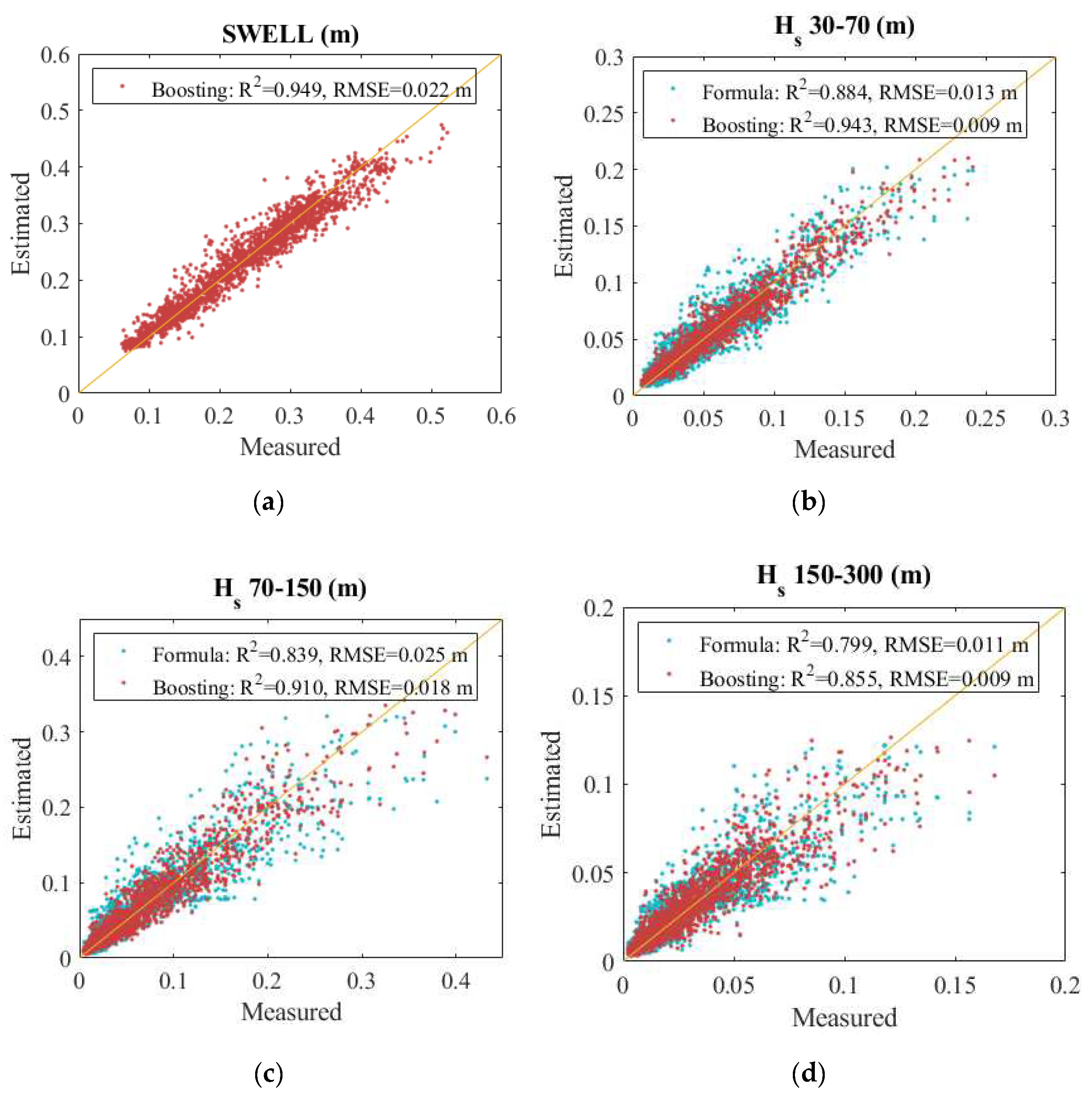

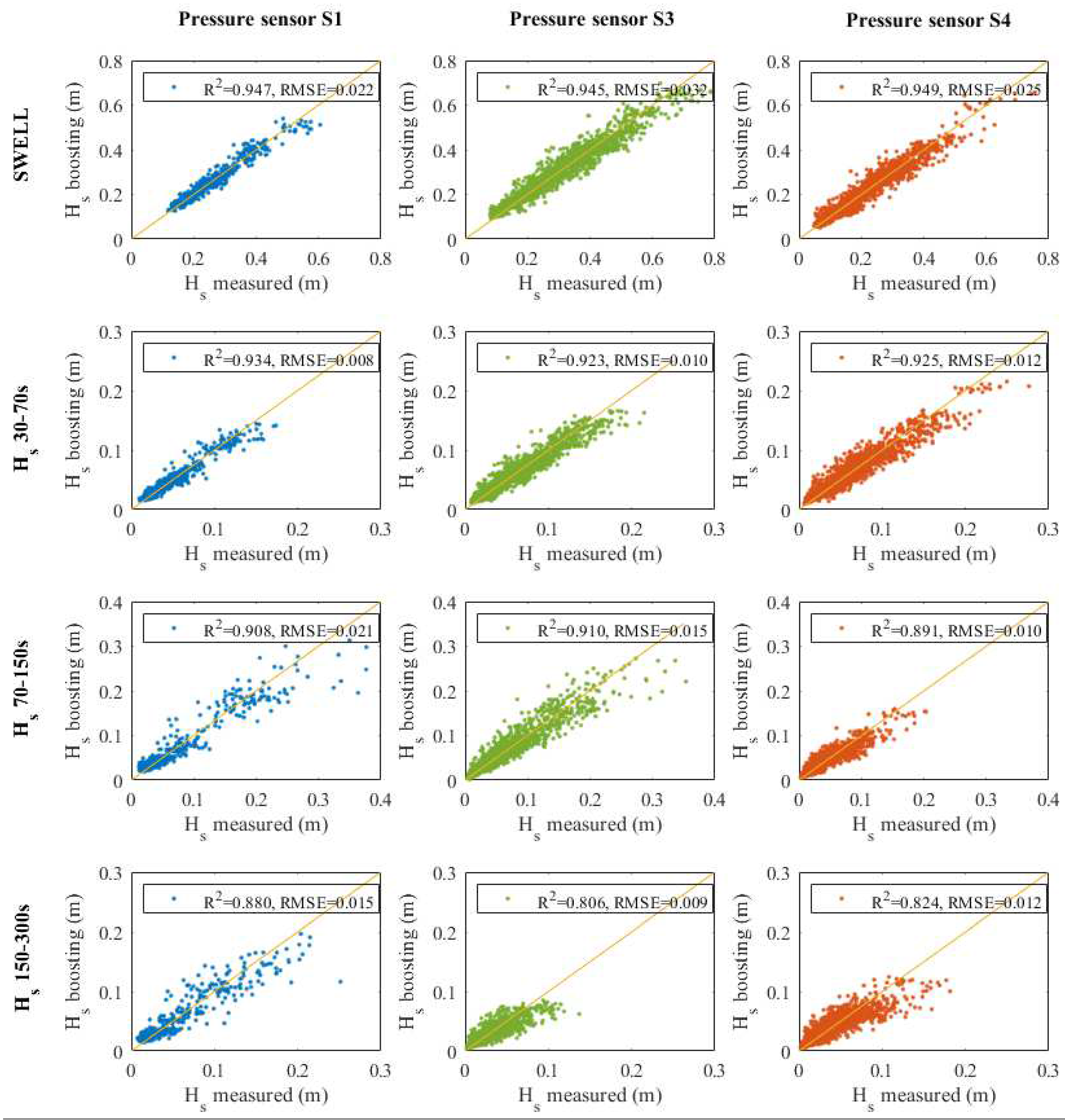
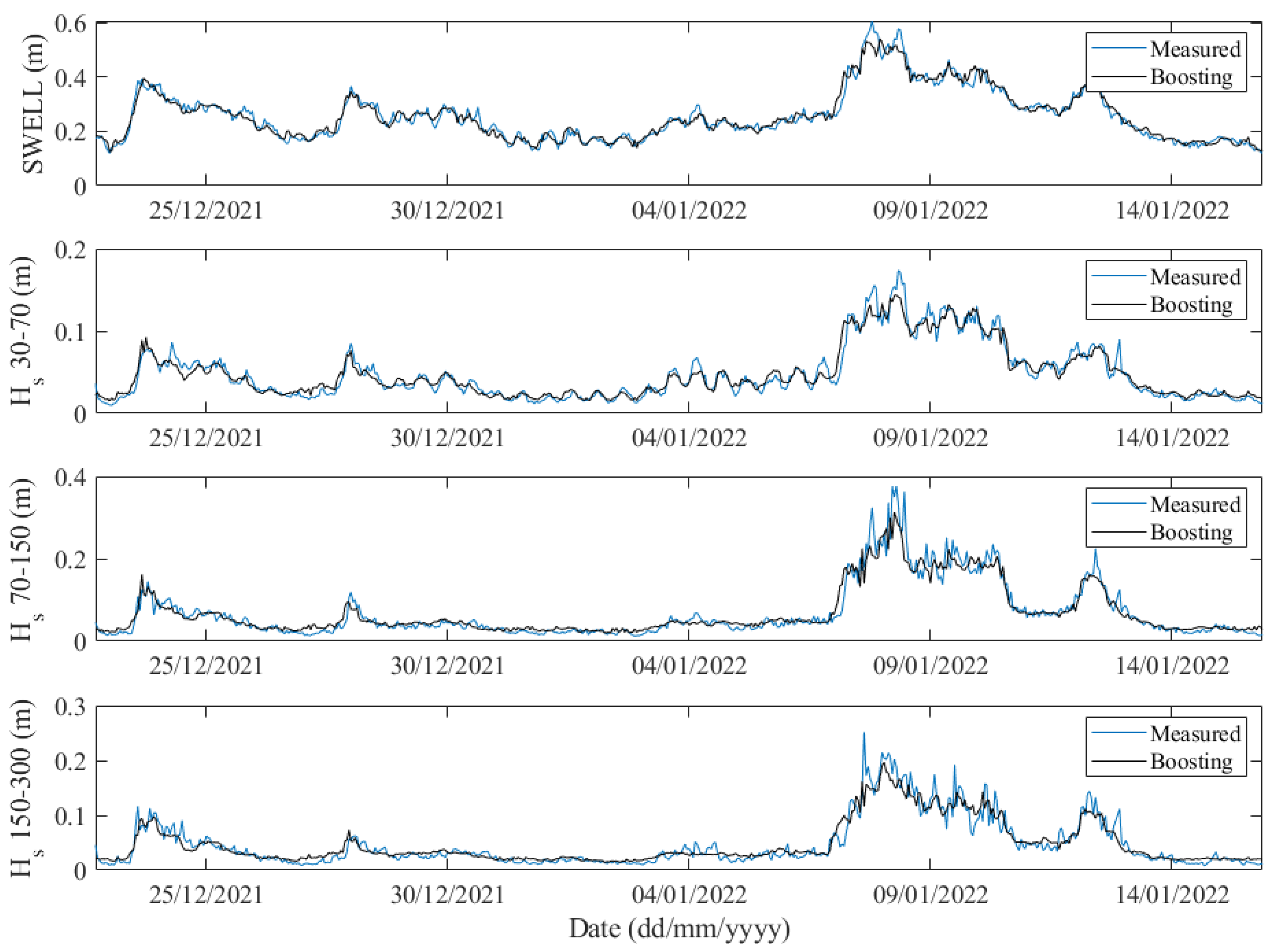

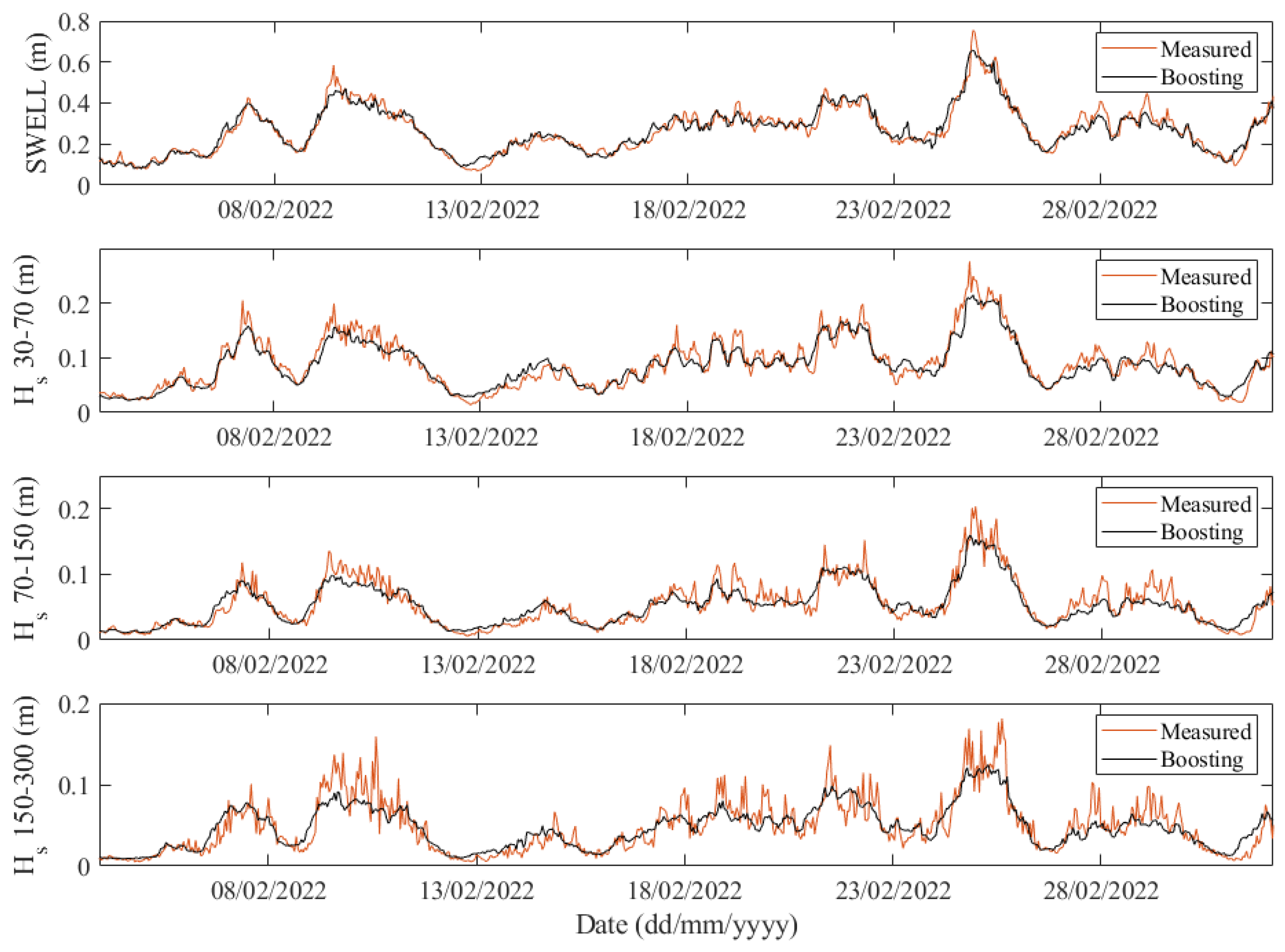
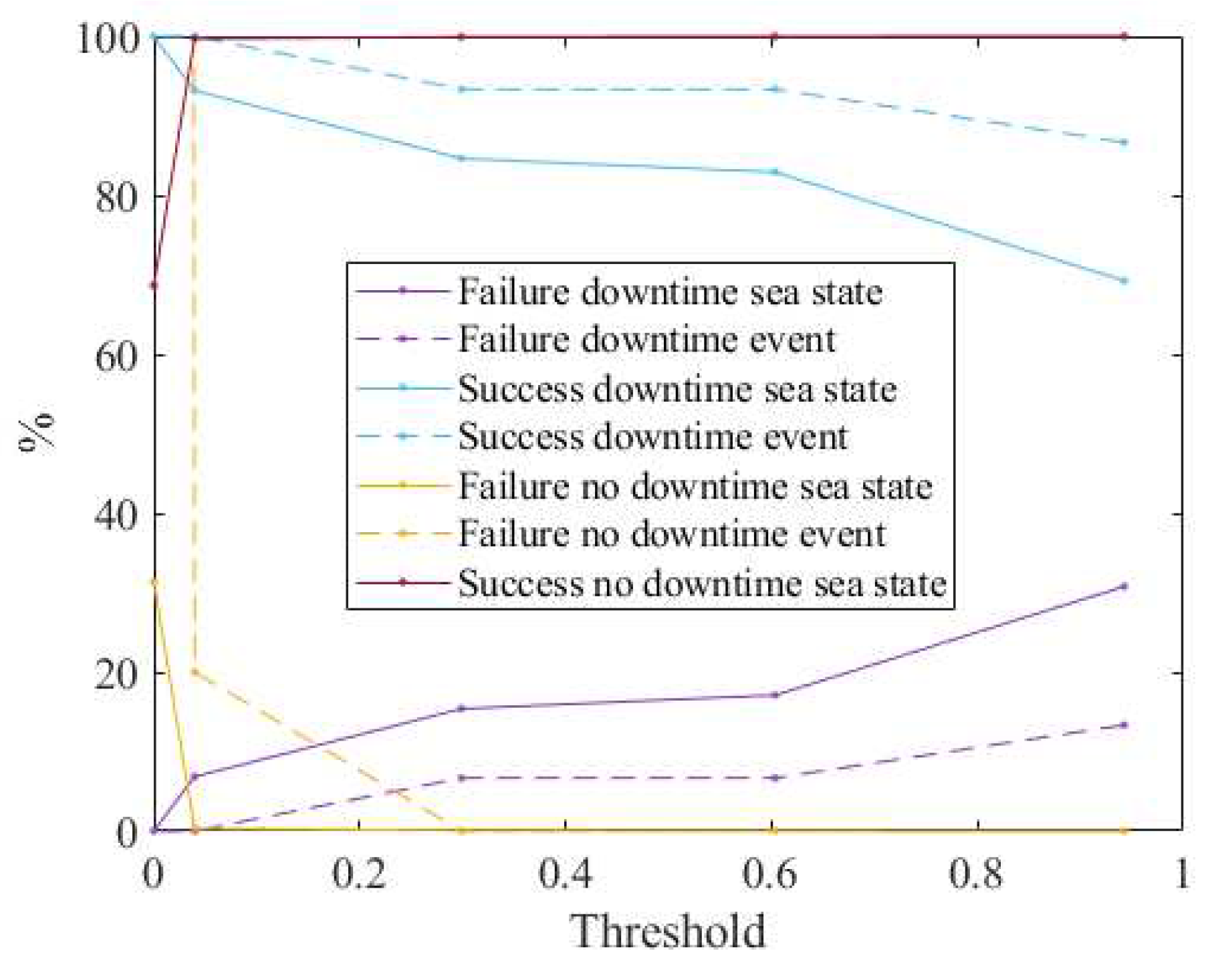
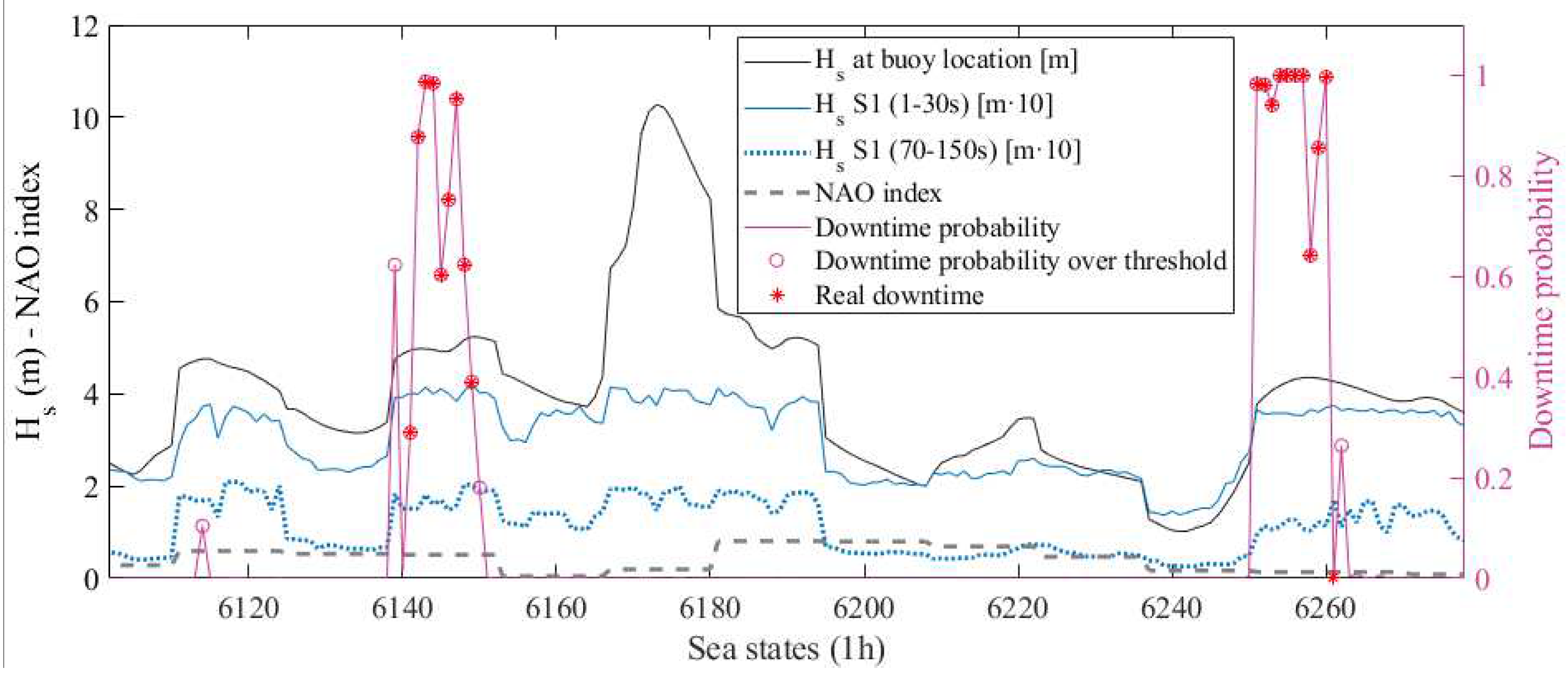

| Name | DWT (t) | Overall Length (m) | Beam (m) | Type | Location at Dock | Date |
|---|---|---|---|---|---|---|
| Lowlands Saguenay | 37,152 | 180.0 | 30.0 | Operability | Z5 | 2 February 2017 |
| Isartal | 3711 | 87.8 | 12.9 | Operability | Z5 | 30 January 2019 |
| Manisa Alena | 35,063 | 108.0 | 30.0 | Operability | Z5 | 11 November 2019 |
| Wilson Newport | 8321 | 123.0 | 16.7 | Operability | Z5 | 20 November 2019 |
| Juergen K | 3785 | 88.8 | 12.5 | Operability | Z3 | 13 February 202 |
| Waaldijk | 4891 | 89.9 | 14.4 | Operability | Z4 | 16 February 202 |
| Amalia | 35,063 | 180.0 | 30.0 | Operability | Z6 | 20 November 2019 |
| Waaldijk | 4891 | 89.9 | 14.4 | Operability | Z6 | 29 October 2020 |
| John Paul K | 4247 | 90.3 | 15.2 | Safety | Z4 | 2 February2017 |
| Fulda | 4433 | 99.9 | 12.8 | Safety | Z5 | 2 February 2017 |
| Moraime | 7300 | 118.0 | 16.5 | Safety | Z3 | 17 January 2018 |
| Zealand Beatrix | 13,089 | 134.7 | 20.5 | Safety | Z4 | 12 November 2019 |
| Rose | 3603 | 101.1 | 14.6 | Safety | Z3 | 20 November 2019 |
| Juergen K | 3785 | 88.8 | 12.5 | Safety | Z4 | 13 February 2020 |
| Mario C | 13,000 | 130.0 | 22.0 | Safety | Z5 | 28 October 2020 |
| Authors | k | α | β | γ |
|---|---|---|---|---|
| Port of Langosteira Hs 30–70 s | 0.00042 | 1.374 | 0.536 | −0.566 |
| Port of Langosteira Hs 70–150 s | 0.00017 | 1.664 | 0.815 | −0.571 |
| Port of Langosteira Hs 150–300 s | 12.343 | 1.474 | 0.761 | 2.698 |
| Ref. [54], Port of Ferrol | 0.005 | 1.265 | 1.3 | 0.328 |
| Ref. [54], Port of Ferrol | 0.002 | 1.264 | 1.293 | - |
| Ref. [48], Port Talbot | 0.0064 | 1.32 | 1.17 | 0.34 |
| Ref. [48], Shoreham Port | 0.0074 | 0.93 | 0.99 | 0.06 |
| Ref. [48], Barrow-in-Furness | 0.0024 | 1.08 | 1.59 | 0.36 |
| Ref. [55], Marina di Carrara | 0.0084 | 1.2 | 0.78 | 0 |
| Method | Formula | Gradient Boosting (GBM) | ||||||
|---|---|---|---|---|---|---|---|---|
| Input Parameters | Hs, Tp and SWL | Hs, Tp and SWL | Hs, Tp, Dir and SWL | Hs, Tp, Dir, SWL, Vw, Dirw and NAO | ||||
| Statistics | R2 | RMSE (m) | R2 | RMSE (m) | R2 | RMSE (m) | R2 | RMSE (m) |
| Hs swell (1–30 s) | - | - | 0.88 | 0.033 | 0.93 | 0.026 | 0.95 | 0.022 |
| Hs LIG (30–70 s) | 0.88 | 0.013 | 0.90 | 0.012 | 0.92 | 0.011 | 0.94 | 0.009 |
| Hs UPG (70–150 s) | 0.84 | 0.025 | 0.85 | 0.024 | 0.88 | 0.021 | 0.91 | 0.018 |
| Hs FIG (150–300 s) | 0.80 | 0.011 | 0.80 | 0.011 | 0.83 | 0.010 | 0.86 | 0.009 |
| Threshold | Sea State | Event | |||||
|---|---|---|---|---|---|---|---|
| Downtime | No Downtime | Downtime | No Downtime | ||||
| Success | Failures | Success | Failures | Success | Failures | Failures | |
| 0.940529 | 81 | 36 | 11,228 | 0 | 13 | 2 | 0 |
| 0.603581 | 97 | 20 | 11,225 | 3 | 14 | 1 | 0 |
| 0.298837 | 99 | 18 | 11,219 | 9 | 14 | 1 | 0 |
| 0.039730 | 109 | 8 | 11,194 | 34 | 15 | 0 | 3 |
| 0.000048 | 117 | 0 | 7706 | 3522 | 15 | 0 | 501 |
Disclaimer/Publisher’s Note: The statements, opinions and data contained in all publications are solely those of the individual author(s) and contributor(s) and not of MDPI and/or the editor(s). MDPI and/or the editor(s) disclaim responsibility for any injury to people or property resulting from any ideas, methods, instructions or products referred to in the content. |
© 2023 by the authors. Licensee MDPI, Basel, Switzerland. This article is an open access article distributed under the terms and conditions of the Creative Commons Attribution (CC BY) license (https://creativecommons.org/licenses/by/4.0/).
Share and Cite
Costas, R.; Carro, H.; Figuero, A.; Peña, E.; Sande, J. A Decision-Making Tool for Port Operations Based on Downtime Risk and Met-Ocean Conditions including Infragravity Wave Forecast. J. Mar. Sci. Eng. 2023, 11, 536. https://doi.org/10.3390/jmse11030536
Costas R, Carro H, Figuero A, Peña E, Sande J. A Decision-Making Tool for Port Operations Based on Downtime Risk and Met-Ocean Conditions including Infragravity Wave Forecast. Journal of Marine Science and Engineering. 2023; 11(3):536. https://doi.org/10.3390/jmse11030536
Chicago/Turabian StyleCostas, Raquel, Humberto Carro, Andrés Figuero, Enrique Peña, and José Sande. 2023. "A Decision-Making Tool for Port Operations Based on Downtime Risk and Met-Ocean Conditions including Infragravity Wave Forecast" Journal of Marine Science and Engineering 11, no. 3: 536. https://doi.org/10.3390/jmse11030536
APA StyleCostas, R., Carro, H., Figuero, A., Peña, E., & Sande, J. (2023). A Decision-Making Tool for Port Operations Based on Downtime Risk and Met-Ocean Conditions including Infragravity Wave Forecast. Journal of Marine Science and Engineering, 11(3), 536. https://doi.org/10.3390/jmse11030536







